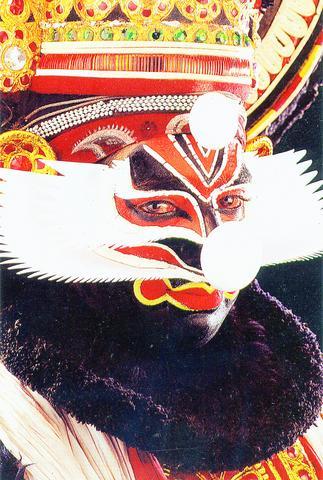The 2004 Indian Cultural Festival gets underway tomorrow in Hsichi's Dream Community, with music, dance, art, handicrafts, lots of authentic Indian cuisine, a puppet show and Kathakali performance. In short, organizers say, it's going to be a complete Indian carnival.
The Indian Music Center and the Wei Gin Yuan Musical Instrument Museum are sponsoring the event and, with the financial backing of the Indian Tourism board, the Indian's Association of Taipei, Taipei City's Department of Cultural Affairs, the Ministry of Foreign Affairs and the Council for Cultural Affairs, no expense has been spared to create a festival that organizers hope will become a major yearly attraction.

PHOTO COURTESY OF ORGANIZERS
"We hope to not only provide an exciting opportunity for people of Taiwan to experience colorful Indian culture, but also to promote the interaction between peoples of the two countries," said Jeffrey Wu of the Taipei Indian Music Center.

Topping a long list of must-sees is a Kathakali performance, India's classical dance drama that employs colorful
costumes and symbolic make-up combined with highly stylized movement, postures and mudra, or expressive gestures, to convey its message. In Kathakali, the actors neither sing nor say lines, but let the Malayalam music narrate stories taken from famous Hindu epics like the Mahabaratha, Ramayana or Bhagavadgita.
Tomorrow's performance is taken from the Bhagavadgita and tells a story of Jayanthan, the son of Lord Indra. The story is set in a time when the three worlds were ruled over by the demon Narakasura, who orders his maid, Nakrathundi, to go capture the damsels of heaven.
On her way back with the captured damsels, Nakrathundi happens upon the young Jayanthan and is smitten with his good looks. She devises a plan to take him as her husband by disguising herself as one of the damsels she's just captured. She appears before Jayanthan and dances for him.
"You must marry me!" Nakrathundi tells Jayanthan.
"Heavenly damsel, I will not marry before my father tells me, so please go away," the filial Jayanthan replies.
As Nakrathundi moves to embrace Jayanthan, he sees through her disguise and chops off her nose and breast.
The moral may have become muddled over the centuries, but the music the story is set to remains wonderful.
If you miss the music, you can at least take a gander at some of the many instruments used to create it in an exhibition at the Core Pacific Living Mall (
At the end of tomorrow's activities there will be a lucky draw for two round-trip tickets to New Delhi sponsored by China Airlines.
Festival activities begin at 11am tomorrow at the Dream Community, located at the intersection of Chungshing Rd and Huchien St. in Hsichi (
A viewer's guide to Kathakali
● An oil lamp is a must in Kathakali performances as it is a devotional drama. The flame represents the presence of the goddess Kali.
● Make-up is an interesting an important part of the drama and is used as a sort of color-coding for the characters:
● Pacha, or green make-up, denotes good, noble or royal characters.
● Black make-up indicates characters that are hunters or demons.
● Characters who appear gentle but are brutes at heart have faces painted red.
● Female characters and sages have simpler make-up of a brownish tinge.
Costumes are made of wood and fabric and weigh up to 40kg.
● Kathakali actors train a minimum of six years before performing in public..

In the March 9 edition of the Taipei Times a piece by Ninon Godefroy ran with the headine “The quiet, gentle rhythm of Taiwan.” It started with the line “Taiwan is a small, humble place. There is no Eiffel Tower, no pyramids — no singular attraction that draws the world’s attention.” I laughed out loud at that. This was out of no disrespect for the author or the piece, which made some interesting analogies and good points about how both Din Tai Fung’s and Taiwan Semiconductor Manufacturing Co’s (TSMC, 台積電) meticulous attention to detail and quality are not quite up to

April 21 to April 27 Hsieh Er’s (謝娥) political fortunes were rising fast after she got out of jail and joined the Chinese Nationalist Party (KMT) in December 1945. Not only did she hold key positions in various committees, she was elected the only woman on the Taipei City Council and headed to Nanjing in 1946 as the sole Taiwanese female representative to the National Constituent Assembly. With the support of first lady Soong May-ling (宋美齡), she started the Taipei Women’s Association and Taiwan Provincial Women’s Association, where she

Chinese Nationalist Party (KMT) Chairman Eric Chu (朱立倫) hatched a bold plan to charge forward and seize the initiative when he held a protest in front of the Taipei City Prosecutors’ Office. Though risky, because illegal, its success would help tackle at least six problems facing both himself and the KMT. What he did not see coming was Taipei Mayor Chiang Wan-an (將萬安) tripping him up out of the gate. In spite of Chu being the most consequential and successful KMT chairman since the early 2010s — arguably saving the party from financial ruin and restoring its electoral viability —

It is one of the more remarkable facts of Taiwan history that it was never occupied or claimed by any of the numerous kingdoms of southern China — Han or otherwise — that lay just across the water from it. None of their brilliant ministers ever discovered that Taiwan was a “core interest” of the state whose annexation was “inevitable.” As Paul Kua notes in an excellent monograph laying out how the Portuguese gave Taiwan the name “Formosa,” the first Europeans to express an interest in occupying Taiwan were the Spanish. Tonio Andrade in his seminal work, How Taiwan Became Chinese,